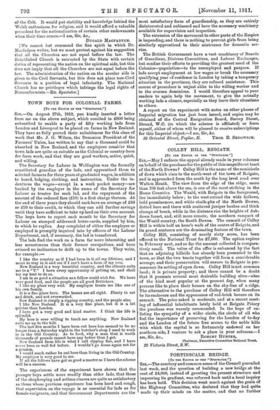COLLEY HILL, REIGATE.
[To PEP EDITOR OF Tax "STEM/T08."] SIR,—May I enforce the appeal already made in your columns on behalf of the purchase for the public of this magnificent tract of the North Downs P Colley Hill is the name of the semicircle of down which rises to the north-west of the town of Reigate, and is approached from the south by the long level road over Walton Heath. The view from the edge of the ridge, more than 700 feet above the sea, is one of the most striking in the Home Counties. The Weald, with Reigate in the foreground, lies immediately below; to the west extend the wide hollows, bold prominences, and white chalk-pits of the North Downs, dotted here and there with scattered juniper bushes and thick clumps of beech, while in the distance rise the heights of Ash- down forest, and, still more remote, the southern rampart of the Weald country, the South Downs. The summit of Colley Hill is within half an hour's walk of the centre of Reigate, and its grand contours are the dominating feature of the town.
Colley Hill, consisting of nearly sixty acres, has been offered to the National Trust for £7,500. The option expires in February next, and so far the amount collected is compara- tively small. The value of the offer is enhanced by the fact that an adjoining hillside has already been presented to the town, so that the two tracts together will form a considerable acreage, and their preservation will ensure to Reigate in per- manence its setting of open down. Colley Hill is not common land; it is private property; and there cannot be a doubt that it presents several most desirable building sites—sites of the kind most popular at the present day, when many persons like to place their houses on the sky-line of a ridge. The alternative to the purchase of Colley Hill will therefore be its enclosure and the appearance of red-brick houses on its summit. The price asked is moderate, and at a recent meet- ing of influential inhabitants lately held at Reigate Priory the purchase was warmly commended. In the hope of en- listing the sympathy of a wider circle, the circle of all who feel the importance of preserving for the London of to-day and the London of the future free access to the noble hills with which the capital is so fortunately endowed on her southern side, I venture to ask a place in your columns.—I
Chairman, Executive Committee National Trust. 25 Victoria Street, S.W.


















































 Previous page
Previous page